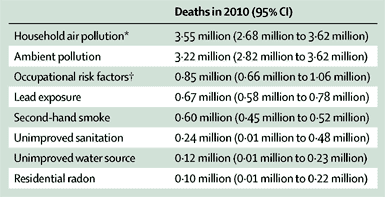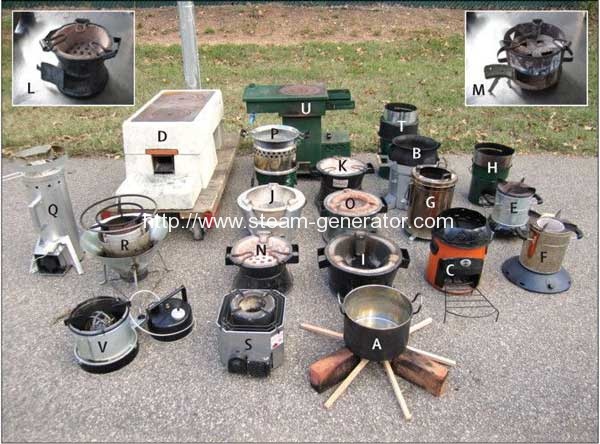indoor air pollution—killing 4 million a year

Indoor air pollution still gets fairly little attention for such a spectacularly lethal public-health problem.
Indoor air pollution now kills 4 million people a year — more than AIDS and malaria combined
Here’s the basic version: About 3 billion people around the world —
mostly in Africa and Asia, and mostly very poor — still cook and heat
their homes by burning coal, charcoal, dung, wood, or plant residue in
their homes. These homes often have poor ventilation, and the smoke can
cause all sorts of respiratory diseases.
All told, indoor air pollution kills between 3.5 million and 4.3
million people each year. To put that in perspective, that’s more deaths
than are caused by HIV/AIDS (around 1.6 million per year) and malaria (around 627,000) — combined.
This month, The Lancet Respiratory Medicine published a big new report taking a detailed look at indoor air pollution — with a map showing where the deaths occur. India
and sub-Saharan Africa are most heavily affected, but it’s a problem
almost everywhere outside of the wealthiest countries:
Indoor air pollution deaths (per million people)

There are a couple of key points in the Lancet study:
1) Indoor air pollution has a wide variety of causes. In
China, tens of millions of rural households still burn coal directly
inside their homes to cook. But in India and Africa, wood and charcoal
are far more common. And in countries like Kenya or Ethiopia where wood
is scarce, animal dung is used. Different fuels lead to different health
problems.
Women and children in extreme poverty are most likely to be affected
Lighting is another big source of indoor air pollution — particularly
the use of unvented kerosene lamps. The study notes that the growing
use of LED lighting is helping here, but “it remains a major problem.”
There are also different reasons for poor ventilation in homes. “In
extreme climates (eg, Nepal, north India), ventilation is deliberately
minimised to conserve energy, resulting in extremely toxic amounts of
[indoor air pollution for much of the year],” the paper notes. “Urban
poor people in Africa often bring a simple cooking stove indoors to keep
their sleeping area warm at night.”
2) Women and children in extreme poverty are most affected. The
paper notes that poor people are most likely to be affected, as they
typically lack access to electricity and have to resort to cheaper fuels
that produce more indoor smoke. What’s more, the cheapest homes, made
of mud or thatch, rarely have chimneys.
In many countries, women still do most of the cooking, so they’re
most exposed — and young children and infants are often nearby. That’s
especially troubling since indoor air pollution does a lot of damage to
young kids.
3) Indoor air pollution kills between 3.5 million and 4.3 million people a year. A
2012 Global Burden of Disease study found that household air pollution
killed 3.5 million people a year — making it the deadliest environmental
problem.

(Gordon et al. 2014)
A follow-up study by the World Health Organization in 2014 upped that estimate to 4.3 million deaths, mainly by including cardiovascular deaths associated with exposure to air pollution.
(Also note that outdoor air pollution from coal plants,
vehicles, and other sources is linked to about 3 million deaths per year
— not quite as deadly, but still quite deadly.)
The Lancet study spends a lot of time exploring the various
respiratory diseases linked to indoor air-pollution exposure. Lung
cancer, for instance, is strongly associated with indoor coal-burning.
Other chronic lung diseases are associated with indoor wood-burning.
Meanwhile, the effects of smoke exposure on young children are still
being explored.
4) All that soot is also a contributor to climate change: This isn’t mentioned in the Lancet paper, but there’s a climate angle here, too. Previous studies have found that soot particles from these cookstoves can settle on nearby
glaciers, absorbing sunlight and melting the ice — particularly in
combination with global warming. The loss of glaciers can, in turn, put
pressure on local water supplies.
As a result, many green groups have turned their attention to tamping down on household air pollution as a way to boost public health and slow the pace of climate change at once.
So what’s the best way to reduce indoor air pollution?
Cookstove types used around the world (A)
Three-stone, minimally tended, wood fuel. (B) Berkeley-Darfur, wood
fuel. (C) Envirofit G-3300, wood fuel. (D) Onil, wood fuel. (E) Philips
HD4008, wood fuel. (F) Philips HD4012, wood fuel. (G) Sampada, wood
fuel. (H) StoveTec GreenFire, wood fuel. (I) Upesi Portable, wood fuel.
(J) GERES, charcoal fuel. (K) Gyapa, charcoal fuel. (L) Jiko, ceramic,
charcoal fuel. (M) Jiko, metal, charcoal fuel. (N) KCJ Standard,
charcoal fuel. (O) Kenya Uhai, charcoal fuel. (P) StoveTec prototype,
charcoal fuel. (Q) Belonio Rice Husk Gasifier, rice hull fuel. (R) Mayon
Turbo, rice hull fuel. (S) Oorja, biomass pellet fuel. (T) StoveTec
TLUD prototype, wood pellet fuel. (U) Jinqilin CKQ-80I, corn cob fuel.
(V) Protos, plant oil fuel. Photo is courtesy of James Jetter, US
Environmental Protection Agency, NC, USA. (Gordon et al. 2014)
Over the last decade, public-health researchers have been exploring
more and more ways to help minimize the effects of indoor air pollution.
And it turns out to be surprisingly difficult.
Outside efforts to persuade households to adopt cleaner technologies often fail
There are plenty of proven technologies out there — including
cleaner-burning cookstoves with better ventilation that use wood or crop
pellets. But efforts by aid groups to persuade communities to adopt
these technologies have often failed.
For example, one 2012 study looked at what happened when randomly selected households in Orissa,
India, were given cleaner-burning cookstoves with chimneys. After a
year, smoke inhalation had dropped compared to control groups. But after four years, there was no meaningful improvement in public
health. Why? Because the households stopped using the stoves after
awhile — they required too many repairs and the chimneys needed constant
sweeping.
Of course, that doesn’t mean it’s all hopeless. A separate 2011 study gave randomly selected households in Guatemala a woodstove with chimney ventilation. That, they found, did seem to reduce cases of childhood pneumonia. The Lancet paper notes that similar randomized control trials for other technologies are ongoing around the world.
The Lancet study also notes some other promising technologies in the future. Some groups have held out hope for clean solar-powered cookstoves,
although the paper notes that these stoves don’t offer nearly as
precise control for cooking, and they’re not wanted if they can’t be
used at night. Indeed, the authors note that people are
unlikely to adopt a new technology just because it’s healthier — it has
to be more convenient too.
And, ultimately, this is another reason why energy access is such a
crucial issue. People in the United States (or even the wealthier parts
of China) don’t need to worry about indoor air pollution because we heat
our homes and cook with electricity and gas. But there are still 1.2 billion people around the world who don’t have any access to electricity at all. It’s
not just an inconvenience — it’s a big public health issue.
Read More: Electric Steam Boilers, Gas Steam Boilers


